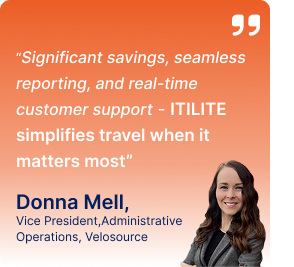
Did you know that companies without automated travel & expense management can spend up to 3x more on processing expenses compared to those with integrated solutions? For a construction CFO, where every project’s profitability hinges on precise financial control, this stark reality underscores a critical opportunity.
Managing employee travel, project-related expenses, and corporate card usage in silos isn’t just inefficient; it’s a direct threat to your bottom line, leading to financial blind spots and operational friction.
The vision is clear: transform these fragmented processes into a unified, transparent system that integrates seamlessly with your core Enterprise Resource Planning (ERP). This isn’t just about saving money; it’s about seeing what’s happening in real-time, staying compliant, and giving your project teams the tools they need to work smarter, so your whole company runs more profitably.
Why Integrated T&E Spend is a Non-Negotiable for Construction CFOs
For travel in construction industry, where margins are tight and crews are always on the move, visibility into travel and expense (T&E) spend is critical. Disconnected systems lead to delays, errors, and overspending across job sites.
An integrated corporate travel and expense platform brings clarity, control, and accountability to every dollar spent. Here are a few key reasons why it is essential:
1. Precise Project Costing
Every dollar, whether it’s a foreman’s flight to a remote site or a hotel stay for a crew working overtime, needs to be accurately tagged to the right project, phase, and cost code. When corporate travel bookings, card transactions, and expense management reports live in separate systems, this process becomes error-prone and delayed.
Integrated T&E solutions ensure that expenses are automatically coded, synced, and pushed into project-level financials in real time, giving CFOs a reliable view of job profitability.
2. A Mobile, Always-Moving Workforce
Field teams are on the go, often in remote locations, juggling site visits and last-minute travel changes. They need corporate travel tools that support mobile expense capture, on-the-fly bookings, and seamless corporate card use, without bouncing between platforms or waiting for approvals.
Integrated T&E platforms eliminate friction, letting employees manage expenses and travel logistics in the flow of work, while staying within company policy.
3. Compliance and Audit Readiness
Construction companies operate under intense regulatory scrutiny. The problem? When travel bookings, corporate card transactions, and expense reports are scattered across different systems, retrieving accurate documentation becomes a last-minute scramble.
An integrated travel and expense management (T&E) platform eliminates this chaos. Every flight, hotel booking, mileage claim, or on-site expense is automatically logged, categorized, and attached to the right project and policy. Digital receipts are captured in real-time, and policy violations are flagged instantly, so there’s no need to sift through spreadsheets or chase missing paperwork later.
Auditors get a clear, centralized trail of approvals, expenses, and usage, all in one place. And your finance team stays focused on strategy, not digging through email chains.
4. Cash Flow Visibility
Without centralized T&E tracking, cash flow can quietly leak across multiple projects, and finance won’t know until it’s too late. Integrated platforms provide real-time dashboards that show actuals vs. budget, identify unusual spend, and highlight project areas that may need attention. That kind of visibility isn’t just convenient, it’s critical for accurate forecasting and avoiding overruns.
5. Risk of Fraud and Misuse
Corporate card misuse is a real and recurring challenge in construction. Field teams often operate with urgency, and without clear boundaries or real-time oversight, even well-meaning employees can overspend or stray outside policy.
Traditional corporate cards lack granularity. Once a card is issued, it’s live 24/7 and often usable anywhere, by anyone who holds it. And if the finance team only finds out during end-of-month reconciliation, it’s too late.
This is where cc authorization transforms the game.
Instead of pre-approving every single purchase, you authorize who can use company funds, how much they can spend, where, and when. itilite issued virtual cards can be:
- Set to expire within hours or after one use
- Capped with a spending limit
- Tied to specific project codes or cost centers
- Limited to specific merchants
These rule-based controls act as real-time guardrails, preventing fraud before it starts. If someone tries to use a card at a gas station when it’s restricted to building materials, the transaction is automatically declined. If spending goes over a limit, it’s flagged or blocked immediately.
The CFO’s 6-Step Implementation Blueprint for Integrated Spend
Creating a streamlined spend process isn’t just about buying software. It requires a strategic rollout across people, policies, and platforms. Here’s a practical path forward:
Step 1: Map the Current Process and Pain Points
Start by laying out your existing tools and workflows. What systems are you using for:
- Booking travel?
- Submitting expenses?
- Managing corporate card transactions?
Identify where delays occur. Are field teams emailing photos of receipts? Is your finance team spending hours reconciling credit card statements? What does card approval look like today?
Make note of which data points your ERP needs, project codes, GL accounts, and cost centers, so your future system can map directly to them.
Step 2: Choose the Right Technology Stack
Look for a platform that combines:
- Travel booking
- Expense management
- Corporate card management
And can integrate with your ERP via APIs.
One example is itilite, which many construction CFOs are turning to for its ability to consolidate these functions. The key is to pick a solution that reduces manual work while keeping your finance team in control.
Don’t forget to check for scalability, mobile access, and strong data security.
Step 3: Implement Centralized Credit Card Authorization (CC Authorization)
This is where the game really changes, especially for construction companies.
With cc authorization, employees don’t have to carry their own cards or wait for reimbursements. Instead, the company authorizes specific travel and project expenses on a centralized corporate card. Employees can:
- Book flights and hotels pre-approved by the system
- Pay for fuel, equipment, or meals directly with the company card
- Capture receipts instantly via a mobile app
Because these transactions are linked in real time, your finance team sees expenses as they happen, not weeks later.
This setup eliminates reimbursement backlogs, reduces fraud, and creates a direct connection between the field and finance. More importantly, it allows you to control spending before it happens, not after.
Step 4: Configure Policy-Driven Expense Automation
Now that corporate card use is centralized, layer in your internal controls:
- Auto-flag out-of-policy purchases (like staying at non-approved hotels)
- Require pre-approvals for high-ticket items
- Block card use for certain merchant categories
- Auto-match receipts to card transactions
Corporate travel platforms like itilite allow for configurable policies tied to project budgets, per diems, and role-based permissions. This ensures that even when employees spend independently, they’re always within the guardrails of company policy.
Step 5: Pilot, Train, and Roll Out Gradually
Run a pilot with a project team or department that frequently travels or makes field purchases. This lets you:
- Identify friction points
- Test corporate card limits and policy logic
- Validate data sync with your ERP
Use this stage to train project managers, engineers, and field supervisors, especially those who will frequently use the app or company card. Emphasize how this reduces their paperwork and speeds up reimbursement (if needed).
Then, expand the rollout in phases across business units or project sites.
Step 6: Monitor, Optimize, and Stay Agile
Once the system is live, your role as CFO shifts from fire-fighting to optimizing.
- Pull monthly reports by project or department
- Analyze trends (e.g., who’s overspending on lodging?)
- Use data to negotiate better vendor rates
- Refine policies as business travel needs evolve
Having a real-time dashboard with card, travel, and expense data tied to specific project codes gives you a true source of financial truth. That’s strategic visibility no spreadsheet can match.
Calculate your savings now!
What You Could Achieve with an Integrated Process
When everything, travel booking, corporate card usage, and expense management, is unified under one roof, the benefits are immediate and measurable:
1. Faster, More Accurate Project-Level Costing
Expenses flow in with the correct GL code, cost center, and project ID already attached. That means accurate job costing from day one, not a month later.
2. Happier, More Productive Field Teams
No more chasing receipts, waiting for reimbursements, or using personal cards with cc authorization. Everything is handled through one system, on their mobile device. This improves field productivity significantly.
3. Stronger Compliance and Fewer Surprises
Real-time controls stop misuse before it happens. Audits become easier because every transaction is logged, categorized, and traceable.
4. Leaner Finance Operations
With automated receipt matching and corporate card reconciliation, your finance team spends less time chasing paperwork and more time analyzing data.
5. Deeper Insight, Smarter Decisions
Use historical spend data for business travel to improve cost estimation for future projects. See which vendors offer the best value. Identify where overspending consistently occurs, and fix it before it eats into profits.
The CFO’s New Role: From Decision Maker to Strategic Architect
The construction industry will always carry a level of complexity, budgets shift, timelines compress, and crews are constantly on the move. But that doesn’t mean your financial infrastructure has to remain fragmented.
When you centralize cc authorization, automate expense management, and streamline travel management under one system, you gain more than efficiency; you gain strategic clarity.
You shift from being the gatekeeper of funds to a strategic architect, building systems that:
- Empower employees
- Protect company assets
- Optimize every project dollar
With tools like itilite providing a unified view of card, expense, and travel activity, you gain the insights you need to scale smarter, budget better, and close faster.
Transform Your Construction Finance Operations Today
With an integrated platform like itilite, you can:
- Enable pre-authorized central corporate card usage tied to project codes in business travel, so field teams can book hotels or buy materials without delays or risk.
- Auto-sync every transaction with your ERP, ensuring financial data is accurate, compliant, and audit-ready.
- Digitize and automate expense management with mobile-first tools, no more chasing receipts or reconciling spreadsheets.
- Provide real-time visibility across all spending categories, so you can manage cash flow proactively, not reactively.
- Enforce policy at the point of spend, not after, with intelligent controls and customizable workflows.
- Support a mobile workforce with intuitive, on-the-go apps that simplify travel booking and expense submission.
- Accelerate the month-end close and reduce audit stress with complete, traceable records across every project.
itilite doesn’t just automate tasks; it centralizes decision-making. It gives your finance team, project managers, and traveling employees a single source of truth. One that’s built around visibility, compliance, and speed.
The blueprint is here. Now it’s your move.
Sources and References
- SAP Concur (2024). “Build a business case for spend management software: travel and expense.” SAP Concur Blog. Retrieved from https://www.concur.com/blog/article/build-business-case-for-spend-management-software-travel-and-expense
- PEX Card (2024). “Make deep cuts into your construction company’s cost of fraud.” PEX Blog. Retrieved from https://www.pexcard.com/blog/make-deep-cuts-into-your-construction-companys-cost-of-fraud/
- Construction Financial Management Association (CFMA). “Protecting Your Business: Keeping a Pulse on Occupational Fraud.” Retrieved from https://cfma.org/articles/protecting-your-business-keeping-a-pulse-on-occupational-fraud
- ExakTime (2023). “Understanding Time Card Fraud in Construction.” Retrieved from https://exaktime.com/blog/time-card-fraud/
- Association for Financial Professionals (AFP) (2023). “2023 AFP Payments Fraud and Control Survey Report.” Retrieved from https://www.jpmorgan.com/content/dam/jpm/commercial-banking/insights/cybersecurity/download-payments-fraud-Survey-key-highlights-ada.pdf
- Corporate card fraud increased from 26% (2021) to 36% (2022)
- ServicePower (2024). “Mobile Workforce Trends.” Retrieved from https://www.servicepower.com/blog/mobile-workforce-trends
- nternational Data Corporation (IDC): US mobile worker population projected to reach 93.5 million in 2024
- Mobile workers represent nearly 60% of the workforce
- Associated Builders and Contractors (ABC) (2025). “Construction Industry Must Attract 439,000 Workers in 2025.” Retrieved from https://www.abc.org/News-Media/News-Releases/abc-construction-industry-must-attract-439000-workers-in-2025
- Autodesk (2025). “100+ Construction Industry Statistics.” Retrieved from https://www.autodesk.com/blogs/construction/construction-industry-statistics/
- 97% of construction businesses identify benefits from greater data use
- 70% of contractors believe in technology benefits
- U.S. Bureau of Labor Statistics. “Construction: NAICS 23.” Retrieved from https://www.bls.gov/iag/tgs/iag23.htm
- Suttle CPAs (2021). “Construction Fraud in a Post-Pandemic World.” Retrieved from https://www.suttlecpas.com/construction-fraud-in-a-post-pandemic-world/
- Construction fraud median loss: 200,000;averageloss:200,000; average loss: average-loss: 1.8 million
- Grant Thornton (2023). “Battling construction fraud in a fragile economy.” Retrieved from https://www.grantthornton.com/insights/articles/real-estate/2023/battling-construction-fraud-in-a-fragile-economy
- Deloitte (2024). “2025 Engineering and Construction Industry Outlook.” Retrieved from https://www2.deloitte.com/us/en/insights/industry/engineering-and-construction/engineering-and-construction-industry-outlook.html
Ready to transform your construction finance operations? Contact our team to learn how itilite can streamline your travel, expense management, and corporate card processes.
Implementation typically takes 4-8 weeks depending on company size and complexity. This includes system setup, ERP integration, policy configuration, pilot testing, and full rollout with training.
The first step is conducting a comprehensive audit of your current travel, expense management, and corporate card management processes to identify pain points, inefficiencies, and integration requirements with your existing ERP system.
Yes, piloting with a single project team or department is highly recommended. This allows you to test functionality, refine policies, and gather feedback before company-wide implementation.
Historical expense data can typically be migrated from your current systems. The migration process includes data mapping, validation, and testing to ensure continuity of financial records.
A phased rollout approach allows the parallel operation of old and new systems temporarily. Clear communication, training schedules, and dedicated support ensure smooth transitions for each team.
Most platforms offer extensive customization including project-specific approval workflows, construction industry expense categories, equipment rental tracking, and job site-specific spending controls.
Success depends on comprehensive training, clear communication of benefits, mobile-first design, and demonstrating how the system reduces paperwork and speeds up reimbursements.
Most construction companies see ROI within 6-12 months through reduced processing costs, improved compliance, better project costing accuracy, and decreased fraud.
Companies typically reduce expense processing costs by 60-80% through automation, with some seeing savings of $15-25 per expense report processed.
Main costs include software licensing, implementation services, ERP integration, training, and ongoing support. Many providers offer transparent, per-user pricing models.
Most platforms offer tiered pricing based on number of users, with volume discounts for larger organizations. Some include unlimited transactions within user limits.
Potential additional costs may include custom integrations, advanced reporting features, premium support levels, or specialized training for complex workflows.
Calculate time spent by finance staff on expense processing, project managers on approvals, field staff on paperwork, plus costs of errors, delays, and compliance issues.
Companies typically see immediate benefits from fraud reduction, with payback often occurring within the first quarter through prevented losses and improved compliance.
Integration typically occurs through APIs that sync transaction data, project codes, GL accounts, and approval workflows in real-time with your ERP system.
Most platforms support major ERPs including SAP, Oracle, Microsoft Dynamics, Sage, Viewpoint, and Procore, with pre-built connectors for construction-specific systems.
Yes, enterprise-grade platforms can integrate with multiple ERPs simultaneously, maintaining separate data flows and configurations for each system.
Yes, the system can be configured to match your existing financial structure, including project codes, cost centers, GL accounts, and custom fields.
Mobile apps typically offer offline functionality, allowing expense capture and data entry without internet, with automatic sync when connectivity is restored.
Enterprise platforms provide automated daily backups, disaster recovery procedures, and data retention policies that meet industry standards and compliance requirements.
Reputable providers offer 99.9% uptime guarantees, 24/7 support, and backup systems. Mobile apps can function offline during any service interruptions.
Leading platforms use bank-level encryption, SOC 2 compliance, multi-factor authentication, and regular security audits to protect sensitive financial data.
Most enterprise platforms comply with SOX, GDPR, PCI DSS, and industry-specific regulations, with built-in audit trails and compliance reporting features.
Automated documentation, digital receipt storage, complete audit trails, and compliance reporting significantly reduce audit preparation time and improve accuracy.
Yes, you can configure multiple approval workflows based on expense type, amount, project, employee level, and other criteria specific to your business needs.
The system allows role-based spending limits, project-specific budgets, daily/monthly caps, and merchant category restrictions based on employee roles and responsibilities.
Advanced platforms include duplicate receipt detection, policy violation flagging, unusual spending pattern alerts, and real-time transaction monitoring.
Systems include role-based access controls, data encryption, privacy settings, and compliance with data protection regulations to safeguard employee information.
Mobile apps are designed for field use with offline capability, GPS integration, photo capture, voice-to-text, and simplified interfaces optimized for construction environments.
Yes, mobile apps include advanced OCR technology that automatically extracts data from receipt photos, reducing manual data entry and improving accuracy.
Most platforms offer native apps for both iOS and Android, with consistent functionality across platforms and regular updates for new features.
Yes, mobile apps typically include full approval functionality, allowing supervisors to review, approve, or reject expenses from anywhere with push notifications for pending items.
GPS functionality can automatically track business travel trips, calculate mileage, and create expense entries, reducing manual entry and improving accuracy for field teams.
All data is stored securely in the cloud, so losing a device doesn’t result in data loss. Remote wipe capabilities protect sensitive information on lost devices.
Reports include project-specific expense summaries, budget vs. actual comparisons, spending trends, vendor analysis, and cost center breakdowns with drill-down capabilities.
Yes, offline functionality allows expense capture and data entry without internet connection, with automatic synchronization when connectivity is restored.
Real-time dashboards provide immediate visibility into spending as transactions occur, with customizable views for different stakeholders and automatic alerts for budget thresholds.
Most platforms offer report builders with drag-and-drop functionality, custom fields, filters, and scheduling options to create reports tailored to your requirements.
Historical spending data, trend analysis, and predictive analytics help improve budget accuracy for future projects and identify potential cost overruns early.
Resources include online knowledge bases, video tutorials, user communities, direct support channels, and dedicated customer success managers for enterprise clients.
Reputable providers offer customer references, case studies, and opportunities to speak with existing construction clients about their implementation experience and results.







